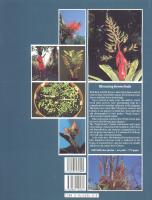
Ulrich and Ursula Baensch
Tropic Beauty Publishers
November 1994 ISBN 0-9641056-0-8
 |
BLOOMING BROMELIADS Ulrich and Ursula Baensch Tropic Beauty Publishers November 1994 ISBN 0-9641056-0-8 |
"This book opens the reader the gate to the world of bromeliads, the most interesting tropical plant family you can find."
This opening statement pretty much sums up the purpose of this book. It is a large sized, 9x11, 268 page, coffee table book. The entire book is packed with some of the most beautiful bromeliad photographs I've seen. It has been extensively researched, with Harry E. Luther and Robert W. Read, Ph.D. acting as taxonomic consultants.
The first part of the book gives a bit of history about Tropic Beauty. This is what the Baensch's call their home in the Bahamas. Included in this section is a bit of information about how the photographs were taken, what equipment they used, etc. From here they give a brief historical discussion of the study of bromeliads.
The next section is concerned with bromeliads in habitat and gives accounts of several collecting trips the Baensch's have made to Costa Rica and Mexico. There are some excellent photo's of bromeliads in habitat and the stories of their adventures are interesting. They give good descriptions of the collecting localities as well.
Starting with two maps giving the distribution of the family bromeliaceae, they give a concise discussion of the biology and botany of bromeliads. This section is packed with information and well worth reading several times, especially for the neophyte. Again there are many photo's that illustrate the text.
The following sections are the heart of the book. They are divided into the three subfamilies of Bromeliaceae. They are Bromelioideae, Pitcairnioideae, and Tillandsioideae. Each section starts by giving information on culture, and other distinguishable features unique to that subfamily. From there they break things down into each genra within that subfamily, again starting each section with a discussion of culture, etc.
At the risk of sounding redundant, I'll again state how beautiful the photo's are. Each plant has been caught at it's peak of flowering. The publishers are to be commended on the excellent job they did in reproducing the photographs. The color is very true. Each photograph is accompanied by a short discussion of the plant, giving information as to size, culture, habit and any other pertinent information. This is followed by a few lines about where the species is found naturally. The authors chose an unusual way to key the photo's to the discussion. Each page is divided into a grid and next to each discussion is a grid map, highlighting the location of the accompanying photo. I found this a bit confusing at first but quickly got used to it. I'm not sure why they used this method as opposed to a simpler plate numbering method.
The book continues with several chapters on many aspects of bromeliads. Let me list them; Frogs and Bromeliads, Culture and Propagation, Care of Tillandsias, Hybridization of Bromeliads, Diseases and Pests, Packing and Shipping, and Bromeliads in House and Garden. Each chapter is packed with information that can be useful to both the hobbyist and the professional. Again there are many photo's illustrating the text.
The final chapter, Buds and Blooms, is an epilog of sorts. It is an expression of the care and love that went into creating this magnanimous work. It is apparent that the Baensch's have a deep devotion to bromeliads and their culture, not to mention each other. This chapter is followed by a brief bibliography and the index.
I can't recommend this book highly enough. Not every plant in the family is here, but most cultivated species are covered. This book covers mostly species, I might add. There are some hybrids, mostly in the Neoregelia section, sprinkled throughout. It is a shame that the book is no longer being printed, as it should be one of the first acquisitions for anyone starting out in bromeliads, perhaps even before starting to collect plants! We can only hope that a second printing will be coming in the not too far distant future.  The next two chapters, Meaning of Plant Names and Glossary of Botanical Terms are interesting. The former being very complete and gives one who is not fluent in Latin, a sense of why plants get the names they do. The glossary is a bit short but still informative.
The next two chapters, Meaning of Plant Names and Glossary of Botanical Terms are interesting. The former being very complete and gives one who is not fluent in Latin, a sense of why plants get the names they do. The glossary is a bit short but still informative.
Aloha,
Rusty Luthe
Telescope System Specialist, James Clerk Maxwell Telescope
Mauna Kea Hawaii
luthe@jach.hawaii.edu
"If it's not one thing it's another......"